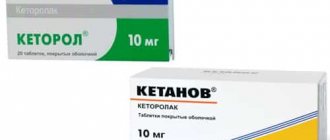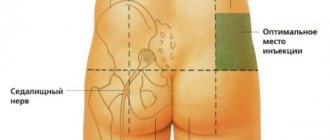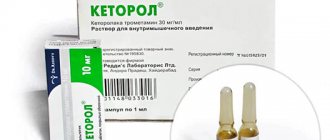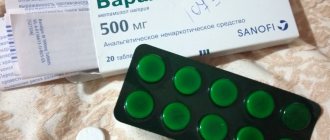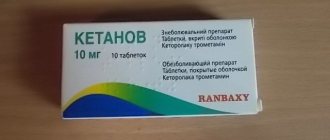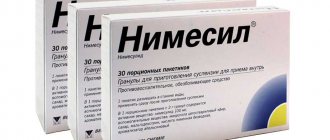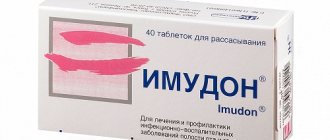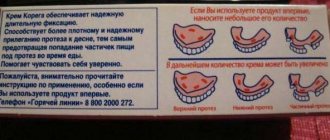Ketorol (its known analogues - ketanov and dolac) is a non-steroidal anesthetic with anti-inflammatory and slight antipyretic effects. Injections of the drug have a positive effect almost immediately. The tablets also act quickly (within half an hour). Ketorol is used to relieve neuralgia and spasms, and to eliminate severe pain in teeth and joints.
The drug is not considered dangerous and does not lead to addiction, forcing you to increase doses. However, ketorol has many contraindications. In particular, it is strictly prohibited to use it together with alcoholic beverages of any strength . It is also not recommended to use it to relieve a hangover.
Ketorol - description, action
The drug Ketorol is available in different dosage forms. Most often in pharmacies you can find 10 mg tablets, 20 pieces per package (the product costs about 50 rubles). The tablets are covered with a green coating and have an “S” engraving on one side. In addition, the following forms of the drug are produced:
- solution in ampoules for intramuscular, intravenous administration (1 ml each);
- gel 2% for external use (30 g each).
The active ingredient in all three dosage forms is the same - it is a representative of the group of non-steroidal anti-inflammatory drugs (NSAIDs) ketorolac tromethamine. In tablets, the auxiliary components are starch, lactose, magnesium stearate, collidon, talc, etc.
The drug has an analgesic and anti-inflammatory effect, like other NSAIDs. Ketorolac is a derivative of pyrrolizine carboxylic acid; when it enters the body, it inhibits the activity of COX 1,2 enzymes. The latter are precursors of inflammatory mediators - substances released during pain, inflammatory response and increasing discomfort. The drug also has an antiplatelet effect - it thins the blood, preventing platelets from sticking together.
The most powerful effect of Ketorol is an analgesic; it also has a moderate antipyretic effect.
When taking tablets, the maximum concentration of ketorolac in plasma is achieved after 40 minutes. The effectiveness of the product does not depend on food intake. The substance is excreted in the urine, and in a small part - through the intestines.
special instructions
Ketorolac affects blood clotting, but this effect is limited in time and lasts no more than 1-2 hours. Ketorol is not able to replace the preventive effect of acetylsalicylic acid on platelet aggregation. Therefore, patients taking acetylsalicylic acid drugs in moderate doses as anticoagulants should not refuse them.
If there is a risk of gastropathy, proton pump inhibitor drugs and antacids are simultaneously prescribed. While using the drug, it is necessary to monitor hemostasis parameters once a week. Elderly people have a higher risk of developing side effects, so they should use Ketorol in minimal doses.
Due to the risk of adverse reactions, the first dose of the drug should be administered under close medical supervision.
Since the drug can often cause side effects such as dizziness and drowsiness, during the course of treatment you should avoid driving and performing work that requires concentration.
More and more often, modern people resort to potent drugs (analgesics). And really, is it worth enduring pain when you can relieve it quickly and without harm? Is there no harm? To answer these questions, let’s take ketorol as an example, the indications for its use: when to take it, and when it’s better to abstain.
Most often, children of the 21st century are bothered by toothache, headaches, muscle pain, severe pain after major operations, and serious illnesses (oncology) also make themselves felt. In all these cases a strong remedy is required. Among modern drugs, only a few meet this requirement: Nise, Ketorol, Nurofen.
These drugs are sold without a prescription. A prescription is required for (such as morphine, codeine). Although the painkillers mentioned above contain drugs: codeine in Nurofen. The safest are drug-free analgin, citramon, ibuprofen and paracetamol. They are not addictive, but in severe cases they are not effective.
Doctors, and even consumers of painkillers themselves, call ketorol and its derivatives (ketorolac, dolac, ketanov, toradol) the most effective. Ketorol is a painkiller that has a very strong effect, acts on the body in a similar way to morphine, and is at the same time more dangerous than others.
It is generally not recommended to take it without a doctor. And since doctors are cautious, and the pain is tempting you to try something stronger, let’s figure out whether it’s worth taking ketorol. Indications for use are as follows: postoperative period, accompanied by severe pain; for advanced oncological diseases; diseases of the musculoskeletal and connective tissue, i.e. muscle pain (myalgia), nerve pain (neuralgia), joint pain (arthralgia).
Can be used to relieve pain from dislocations, sprains, and other serious injuries, as well as radiculitis and rheumatism. Ketorol is effective for toothache. Although in some cases it is better to take nise (it will be enough to relieve a mild toothache). If you have abdominal pain, you should not take ketorol; the indications for use in the drug instructions do not include these cases. It is also not wise to relieve a headache with such a strong drug.
In addition to the analgesic effect, ketorol has an anti-inflammatory and antipyretic effect. However, the drug is not used to treat such diseases, but only for the sole purpose of relieving pain in inflammatory diseases and others accompanied by fever.
The drug does not cause dependence on it. However, sometimes there is a decrease in attentiveness, the ability to react quickly, drowsiness, and decreased clarity of vision (these are adverse reactions). It's definitely not worth driving.
We invite you to familiarize yourself with the Irrigator for cleaning interdental spaces
Available in tablets and ampoules for intramuscular injections, they will certainly have a stronger effect.
Of course, you shouldn’t endure the pain, but you also shouldn’t resort to strong drugs when you can cope with safer means! Scientists are sounding the alarm for good reason: recent studies have shown that constant use (more than once every two weeks) of analgesics leads to the opposite result (provokes pain).
You should always carefully read the contraindications. In many cases, ketorol is contraindicated for patients as a pain reliever. Indications for its use are a much shorter list than contraindications. Among them are asthma, ulcers, blood clotting disorders, bleeding, severe liver, kidney, and heart failure. Pregnant and breastfeeding women, children under 16 should not take it at all! It is also contraindicated for elderly people.
Not to mention the side effects, most of which are as difficult to bear as severe pain (cramping, burning, vomiting, diarrhea or, conversely, constipation, swelling, headache).
Always remember: pain is a signal from the body indicating the need for treatment. Therefore, after relieving the pain, you should not forget about it; you need to find out the causes and undergo treatment if necessary.
Catad_pgroup NSAIDs
Indications for use
The drug Ketorol in tablets helps against pain of various localizations and various origins. It should be taken into account that the drug can be given only as a symptomatic remedy, because it does not affect the course of the underlying disease. In some cases, NSAIDs can mask the symptoms of pathology, thereby delaying the start of taking etiotropic drugs (this is most important in case of an infectious process).
The drug has a powerful analgesic effect, it is advisable to use it for severe and moderate pain with:
WE RECOMMEND THE ARTICLE!
Nimesil helps with toothaches, sore throats due to colds, and also with painful periods. Read more >>
- caries, pulpitis, gum diseases, accompanied by pain;
- tooth extraction, dental operations;
- headache, migraine;
- damage to the spine due to osteochondrosis, rheumatism, radiculitis, when lumbago occurs;
- injuries to ligaments, muscles, bone fractures, joint injuries.
The medicine is often used to relieve pain due to arthrosis and arthritis of the joints. Its action is very different from that of hormonal drugs or anesthetics (for example, Dexamethasone and Lidocaine) - it acts only for a few hours, no more. Ketorol is also prescribed for pain in cancer patients, after operations, for neuralgia, and painful menstruation.
When can you get poisoned?
Poisoning with ketorolac, in any of the drugs containing it, can occur for the following reasons:
- excessive dosage;
- use of expired medicine;
- taking the normal dose over 65 years of age;
- use of the drug for more than five days;
- use of medicine stored at the wrong temperature.
Since death does not occur with a significant increase in dose from this drug, it is not used in suicidal cases. But it can cause numerous reactions and side effects. It is especially important to monitor how a child or elderly person takes this medicine. After all, old people, due to their absent-mindedness, can forget whether they took a Ketorol tablet today, and how many times this has already happened.
Since death does not occur with a significant increase in dose from this drug, it is not used in suicidal cases. But it can cause numerous reactions and side effects. It is especially important to monitor how a child or elderly person takes this medicine. After all, old people, due to their absent-mindedness, can forget whether they took a Ketorol tablet today, and how many times this has already happened.
We invite you to familiarize yourself with the doctor’s position during tooth extraction
Instructions for the drug
The drug is recommended only for adults; children under 16 years of age are not allowed to take it. The order of use of the medicine is as follows:
- dose - 10 mg every 4-6 hours, the interval between doses cannot be shortened;
- in severe cases, the dose is increased to 20 mg, tablets are taken 3-4 times a day;
- maximum daily dosage - no more than 80-90 mg;
- for people with liver and kidney damage, elderly patients, patients with low body weight (up to 50 kg), the maximum daily dosage is 60 mg.
The use of the medicine without a doctor's prescription is allowed only as a one-time measure and taking into account contraindications. The course of therapy rarely exceeds 5 days, otherwise the risk of side effects increases. Taking Ketorol simultaneously with other NSAIDs and alcohol is strictly prohibited - this contributes to bleeding, gastric ulcers, and increased blood pressure. People with chronic inflammatory processes in the gastrointestinal tract are recommended to take the medicine together with antacids or Omeprazole.
Rules for taking Ketorol during breastfeeding
Despite the fact that Ketorol is contraindicated during lactation, some experts prescribe it to nursing mothers and do not see any harm to the health of a developing baby from a single dose of the medicine. Moreover, according to the electronic Spanish medical directory E-lactacia, this medication is compatible with breastfeeding.
Rules for taking Ketorol tablets while breastfeeding
The tablets contain the lowest concentration of the active ingredient ketorolac. According to the instructions, you need to take no more than 4 tablets per day. But no doctor will prescribe such a dose to a young mother. Usually a one-time dose of the drug is prescribed. The maximum concentration of the substance in a woman’s body is reached one hour after taking the medicine. Before taking Ketorol, a woman needs to express breast milk and temporarily stop lactation. You can start putting your baby to the breast at least 6 hours after using the medicine.
Ketorol tablets are available only with a doctor's prescription. And their independent use, even one-time use, by a nursing mother is unacceptable.
Rules for taking Ketorol gel and injection solution during breastfeeding
Ketorol injection solution has the highest concentration of active substance in its composition. Very often, young mothers after a caesarean section are given the drug Ketorol intramuscularly for three days to dull the pain after the operation. Since women after a cesarean section begin producing milk a little later than those who give birth naturally, the negative impact of the medication on the baby’s body is minimized.
For medical reasons, pain relief with medications after a cesarean section is carried out for three days. After this, at the next round, the doctor asks the woman in labor about the need to extend the pain relief injections. This is especially true for women who, for objective reasons, cannot breastfeed their child.
Ketorol gel is used externally, but nevertheless its active ingredients penetrate into the blood of a nursing woman, and therefore into the body of a developing baby along with milk. A gel is prescribed to relieve pain from dislocations, bruises and sprains. Apply a thin layer to the skin, usually 3-4 times a day.
Thus, the use of all dosage forms of the drug must be strictly controlled by a doctor and lactation must be stopped during the period of its use.
Contraindications and side effects
Strict contraindications to therapy with this drug are acute diseases of the digestive tract, as well as a history of peptic ulcer disease. It is prohibited to be treated with Ketorol if:
- bleeding - pulmonary, gastric, intestinal, with cranial hemorrhage;
- diseases of the blood system associated with coagulation disorders;
- hemorrhagic diathesis;
- severe renal failure;
- severe dehydration;
- allergies to NSAIDs.
You cannot treat with the drug during pregnancy (especially in the early stages), lactation, in childhood, before any operations and in the very early period after surgical interventions. In children under 16 years of age, medication can only be taken for health reasons under the supervision of a physician. Why is the contraindication so strict? In children, after taking it, there is a high risk of developing pulmonary edema, nephritis, and allergic reactions. Side effects include:
- dyspepsia, stomach pain;
- arrhythmia, loss of consciousness;
- development of stomatitis, dry mouth, thirst;
- disorders of the kidneys and liver;
- depression, anxiety, insomnia;
- disturbances of taste, vision;
- disturbances in urinary excretion;
- nosebleeds;
- hyperhidrosis.
Threat of side effects
Most often, the gastrointestinal tract suffers from undesirable manifestations of NSAID treatment, even in injections. Treatment with Ketorol can provoke diarrhea, symptoms of gastralgia; less often, patients complain of constipation, vomiting, flatulence, and there is a possibility of developing focal ulcerations.
According to patient reviews, the drug in injections has a stable effect, but some experience nausea with heartburn after taking the painkiller. Sometimes patients complain of dizziness accompanied by headache, but the symptoms disappear after completing the course.
Infrequently, the response to the administration of Ketorol from the respiratory system is the development of bronchospasm, the appearance of rhinitis, edema of the larynx, even of the lungs. The possibility of ringing in the ears, deterioration of hearing and vision cannot be ruled out. The cardiovascular system may respond to the injection use of Ketorol by increasing blood pressure.
Important: the instructions warn that abuse of Ketorol solution can result in swelling and inflammation, an anemic state, even the development of psychosis, and the appearance of hallucinations.
The key to safe therapy with any type of medication containing ketorolac should be strict adherence to the doctor’s instructions and a ban on self-medication. In addition, before using the medication, it is important to carefully read the instructions supplied with Ketorol, which detail the features of each release form. You should pay attention to the nuances of the interaction of the active substance with various drugs in order to get rid of pain without harming your health.
Republished by Blog Post Promoter
WE ADVISE YOU TO READ:
When to get a flu shot: meeting deadlines is the key to success
Previous article
Nicotinic acid in the form of injections - indications, contraindications and instructions for use
Next article
Analogues and other data
Analogs include a number of drugs that contain the same active substance or other NSAIDs.
| A drug | Active composition | Price, rubles |
| Ketanov | Ketorolac | 60 |
| Ketonal | Ketoprofen | 75 |
| Ketorolac | Ketorolac | 35 |
| Ketocam | Ketorolac | 60 |
| Ibuprofen | Ibuprofen | 15 |
| Diclofenac | Diclofenac | 15 |
| Nise | Nimesulide | 260 |
| Meloxicam | Meloxicam | 20 |
What is stronger, Ketorol or Ketanov, if the products have one active substance? Indeed, the composition of the drugs is similar; they are both NSAIDs based on a derivative of pyrrolysine carboxylic acid. Both drugs have a low price and the same indications. What is the difference between Ketanov and Ketorol, which is better to choose? Doctors say that Ketanov is most suitable for menstrual pain, and Ketorol is best purchased for headaches, although the difference between the drugs is not fundamental.
Is it possible to give Furazolidone to children?
For the treatment of intestinal infections and giardiasis in children, the drug Furazolidone is often prescribed, if necessary in combination with other antibacterial agents. The undeniable advantage of this drug is the slow addiction of infectious agents, rapid absorption in the intestines and good tolerance by patients, but subject to the doses and regimen prescribed by the attending physician.
Furazolidone is an antimicrobial, antiparasitic, antibacterial and anthelmintic drug that also has an antidiarrheal and weak anti-inflammatory effect from the nitrofuran group.
It is effective in treating:
- amoebic dysentery;
- acute bacterial infections caused by salmonella, staphylococci, E. coli, Proteus, Klebsiella;
- food toxic infections;
- paratyphoid;
- Trichomoniasis urethritis.
Furazolidone is actively used by pediatricians to treat giardiasis in children. This disease is accompanied by cramping abdominal pain, lack of appetite, severe nausea and allergic reactions. In this case, several courses of drug therapy with Furazolidone are prescribed.
In this case, the dose, frequency of administration and duration of therapy are determined by the attending physician, which depend on the age and weight of the child, the course of the disease and the type of pathogen, while in parallel with Furazolidone, the child is prescribed sorbents (smecta, activated carbon or enterosgel) to remove toxins from the intestines. This drug is used after meals with plenty of water.
Furazolidone is prohibited from being given to children under one year of age and is strictly not recommended for use in diseases of the nervous system, kidney and/or liver failure.
This drug also has a number of side effects:
- abdominal pain, which may be accompanied by persistent nausea, vomiting, loss of appetite and frequent loose stools;
- fever;
- dizziness;
- angioedema and other allergic reactions (skin rashes with itching and redness of the skin);
- bronchospasm;
- acute pneumonitis;
- arthralgia and myalgia.
These symptoms are aggravated by non-compliance with the dosage regimen and overdose of Furazolidone. If one of these signs is present, the use of furazolidone should be stopped immediately and seek medical help.
Of particular importance is the prevention of intestinal infections and giardiasis based on the need to strengthen the child’s immunity, proper and healthy nutrition for the baby and compliance with all hygiene rules.
Ketorol Express difference from Ketorol
Quite recently, the drug Ketorol Express was introduced to the pharmacological market - its difference from Ketorol ensured its wide popularity and prevalence in the field of non-steroidal anti-inflammatory drugs.
The drugs have an identical composition to the main active substance tromethamine ketorolac. Both medications have a pronounced analgesic, antipyretic and anti-inflammatory effect. Ketorol Express and Ketorolac are characterized by a rapid therapeutic effect, which can be noticed within 1 hour after taking the medication.
The only difference between Ketorol Express and Ketorol is the release form. If the first non-steroidal anti-inflammatory drug is available exclusively in the form of tablets, then the second is also available in the form of a gel for external use.
Thanks to two forms of release, the scope of application of Ketorol is somewhat wider than its analogue. It is prescribed to reduce pain and inflammation in various injuries, bruises, wounds and other soft tissue injuries.
Symptoms and consequences of ketorol overdose
For pain of various origins, including joint pain, neuralgic diseases and even oncological pathologies, doctors prescribe the drug ketorol. These tablets or injections complement the treatment, relieving pain after 30 minutes and providing an anti-inflammatory effect.
An overdose of ketorol can occur for several reasons. It affects a number of internal body systems and has specific symptoms. What are the consequences, is there a lethal dose and what should be done to reduce the concentration of the substance in the body?
Overdose
Symptoms of overdose for parenteral use and oral administration: nausea, abdominal pain, vomiting, renal dysfunction, erosive lesions and ulceration of the gastrointestinal mucosa, metabolic acidosis.
If signs of intoxication appear, the victim is given gastric lavage and enterosorbents are given. Further treatment is symptomatic. Dialysis does not allow ketorolac to be sufficiently removed from the body.
Cases of overdose with external use of the drug have not been described. If you accidentally ingest the gel, you should empty your stomach (induction of vomiting and taking an enterosorbent are indicated) and consult a doctor.
